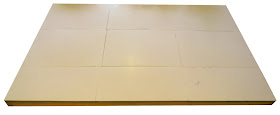Phil Sabin has recently uploaded a YouTube video about his new two-player air combat board game, COUNTER-AIR.
Now, I’ve never really got the hang of air combat wargames, so I looked forward to watching and listening to Phil's explanation of how his game worked … and I was not disappointed!
Phil's video explains the rules of his simple Counter-Air simulation game about attacks on modern airbases. It is a chess-like game of skill and was designed to be used air force personnel as well as wargamers. It is published by the military wargaming group Fight Club International, and can be downloaded for free from their website.
The game sees a superior Blue force attack Red's defended airbase.
The gameboard.
During the game, Blue can mount five sorties with the intention of destroying Red's airbase and its defences whilst minimising its own losses. Red's objective to to prevent this and to cripple Blue's offensive capability.
The game counters. These are double-sided. The reverse side has an S in place of the A to show when the unit is 'spent'.
During the first turn of the demonstration Blue places its forces in the various sections of the playing board according to the task each flight of aircraft is to undertake during the sortie.
Blue's initial positions.
Red counters by placing those assets it intends to use to counter this attack.
Red's initial positions.
Action begins with a flight of Blue's escorting fighters engaging the Red interceptors with AAMs ...
One of Blue's escort flights fires AAMs at a flight of Red interceptors/.
... and Red counters with their own AAMs, causing two flights of Blue's escort fighters to turn for home.
One of Red's interceptor flights returned fire with its AAMs.
The remaining flight of Blue escort fighters then engage a flight of Red interceptors with their AAMs ...
The battle between the Blue escort flights and the Red interceptors continues.
... and a flight of Red interceptors withdraw. One of the remaining flights of Red interceptors now engage a flight of Blue aircraft that are undertaking the high strike role, causing the latter to jettison their bombs.
The red interceptors change target and engage one of Blue's high strike flights.
The remaining flight of Red interceptors follow suit, causing another flight of Blue high strike aircraft to abort their mission.
Red's interceptors continue to engage Blue's high strike aircraft.
As both side's escorts and interceptors are 'spent' (i.e. they are no longer able to take part in further combat until they have returned to their respective basses and rearmed), the game moves into the air defence phase.
The fighting moves on to the next phase. Blue will now try to suppress Red's SAM defences..
Blue begins by trying to suppress Red's SAMs.
One of Red's SAM units is destroyed by weapons fired by a flight of Blue's SEAD (Suppression of Enemy Air Defences) aircraft. The destroyed SAM unit is moved into the Graveyard area on the gameboard.
They manage to destroy one of Red's SAM batteries, but the remaining once Red SAM battery engages one of the Blue high strike flights, destroying it.
The remaining Red SAM unit engages one of Blue's 'spent' high strike flights. The flight is destroyed and placed in the gameboard's Graveyard area.
The combat then continues ... but rather than describe it in detail, I recommend that you watch the video. (I don't want to spoil your enjoyment by telling my regular blog readers what happens next!)
The game is intended to last two hours, with each player having the opportunity to command Blue and Red. The game can be played many times so that players can discover for themselves the best offensive and defensive tactics to employ.
Please note that all the screenshots from Phil Sabin's video are © Professor Philip Sabin.




















































